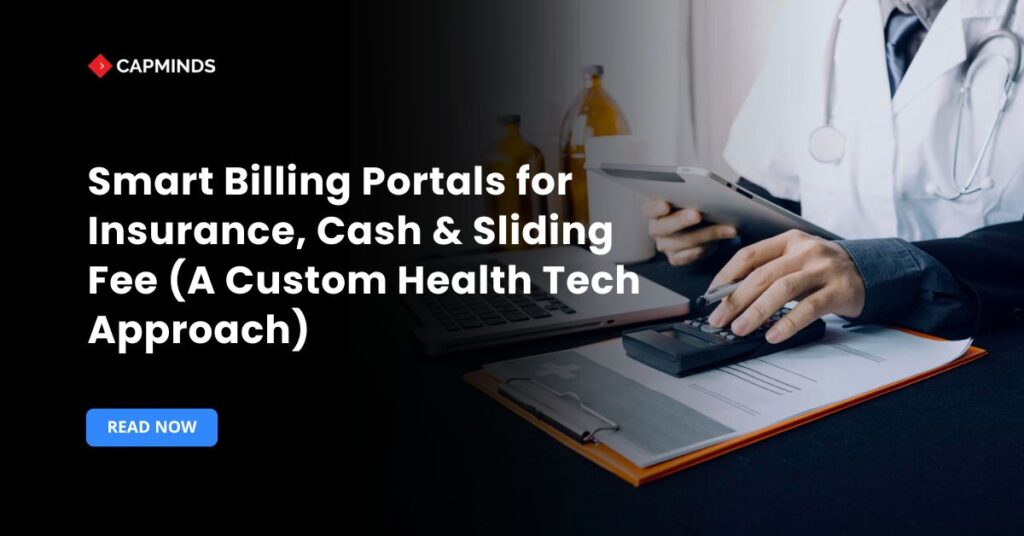Smart Billing Portals for Insurance, Cash & Sliding Fee (A Custom Health Tech Approach)
Healthcare providers contend with a mix of payment models, complex insurance reimbursements, direct patient self-pay, and income-based sliding fee programs. Managing these diverse billing methods with traditional systems is cumbersome and error-prone. As insurance claims grow more complex and administrative tasks multiply, profitability shrinks; even minor billing mistakes can erode revenue.
Modern technology-driven smart billing provides a sophisticated solution. Automate claims, reduce errors, accelerate payments, and improve revenues, ensuring your organization’s financial viability continues as costs increase.
A custom smart billing portal, built on an automation, data analytics, and integrated systems framework, facilitates revenue management while enabling sustainable growth. In this article, we will examine how smart billing portals manage insurance claims, cash payments, and sliding fee schedules, as well as identify the essential innovations that make them integral to effective healthcare finance today.
Modernizing Insurance Billing and Claims Management
Insurance billing is notorious for its complexity. Whether it is patients’ eligibility checks, claim coding, submissions, or checking on the denials, this process requires accurate data at all steps. While legacy billing systems and manual workflows can still ‘do the job’, healthcare staff often explain how they spend time managing paperwork, duplicate data entry, and waiting for payments, which can have frustrating delays and errors, and added stress.
A smart billing portal transforms this process by streamlining and automating each step.
- Advanced platforms combine automation
- Analytics and full system integration to lower error rates
- Speed up payment cycles through direct electronic submissions
- Provide real-time transparency into claim status.
Key enhancements for insurance billing include:
- Automated Claim Scrubbing: The portal automatically filters claims against coding rules and payer criteria by providing flags for errors or missing information before submission. The screening is done before submission which means far fewer claims are denied for issues that could have been corrected. Less rework means more reimbursement that is not lost.
- Electronic Claims and Faster Payments: Smart portals electronically file claims within hours of service instead of through paper and batching. They also track claim status in real time and notify staff of any snags or payer requests.
- Integrated Payer Communication: A platform can integrate directly with the payers’ systems via APIs. Eligibility verification, benefits verification, and even prior authorizations can all happen seamlessly in the background. This integration allows insurance details to be verified upfron,t and claims can be submitted in the right way on the first attempt.
- Denial Management and Analytics: When denials do occur, the portal’s analytics help identify patterns. Built-in denial management tools organize and prioritize follow-up, so staff can address issues quickly. Over time, the system’s intelligence is used to identify issues before they turn into denials, which can be effectively achieved through use of rules, notifications to staff, and identification of trends.
By automating and connecting the process of insurance billing process, hospitals can more efficiently capture revenue and relieve pressure from their billing teams.
Routine claims process themselves “without human clicks,” freeing staff to focus on complex cases or patient service. The result is a more consistent reimbursement cycle with fewer bottlenecks and surprises.
Related: 10 Proven Strategies to Maximize Reimbursements Through Effective Medical Billing
Simplifying Cash Payments and Self-Pay Workflows
Self-pay (cash) patients provide a unique set of payment collection issues. Providers must interact directly with patients to obtain payment while preserving a favorable experience, as insurers are unable to negotiate pricing or ensure payment.
Patients are frequently left perplexed by paper bills and few payment alternatives due to the lack of strong patient-facing features in traditional billing systems.
Billing conflicts, late payments, and even lost revenue may result from this. According to hospitals, enhancing self-pay collections requires open communication and accommodating payment plans.
A smart billing portal greatly improves the self-pay experience and outcomes. Generally, it encompasses a patient-friendly patient portal that permits individuals to view their bills, understand charges, and easily pay online.
Today’s patients expect the same convenience in healthcare billing that they have grown accustomed to in their online shopping; legacy systems that do not offer online portals or payment plans frustrate patients, resulting in more phone calls and write-offs. A custom health tech billing solution addresses these pain points by offering:
Transparent Billing Statements
Patients can log into the portal and see a detailed breakdown of their charges, their discounts, and their amount owed. This clarity fosters trust and lessens confusion to promote payments that are paid promptly.
Multiple Payment Channels
Smart billing portals support payments via credit/debit card, bank transfer, and mobile payment options. Patients can choose to pay in-office, online through the portal, or even set up autopay, whichever is most convenient for them. Offering flexible payment options (online, mobile, installments, etc.) makes it easier for patients to pay, which in turn improves collection rates and patient satisfaction.
Payment Plans and Financing
For larger balances, the portal can provide payment plan options like monthly installments or financing options. This not only helps patients finance their care, but also increases the chances that the provider will collect the balance over time. Built-in plan management tools can automate charge installments and send reminders.
Automated Reminders and Engagement
The system utilizes soft e-bill notifications and texts or emails to remind patients of upcoming or prior payments, allowing the patient to engage without needing involved staff. Early engagement is important; simply communicating and reminding patients is very effective for type of self-pay payments when staff is not involved. We have a 24/7 billing assistant lit help the patient as needed with reminders and support contact directives
Smart billing portals provide patients with an intuitive online experience for managing bills and payments. By offering clear statements and flexible payment methods, these systems improve patient satisfaction and encourage timely payments.
By providing these capabilities, a smart billing portal helps self-pay patients manage their financial responsibilities. Uncomplicated, easy-to-receive bills improve the speed of payments, and create goodwill; the patient feels in charge and respected, not chased after by pesky confusing bills!
Healthcare administrators see higher collection rates on self-pay accounts and minimal bad debt write-off. Having effective self-pay management processes (such as online portals and early outreach) significantly reduces journals’ unpaid balances. The organization realizes effective cash collection and better revenue cycle performance all while providing a better experience for the patient.
Seamlessly Managing Sliding Fee Programs
Many community health centers, hospitals, and clinics offer sliding fee scale programs to ensure care remains affordable for low-income or uninsured patients.
A sliding fee scale adjusts the price for services according to a patient’s income or financial constraints; for example, patients classified as very low income may only pay a nominal fee or a lower fee for their care. While this aspect of sliding fee scales provides a crucial access point for patients, it adds complexity to the billing process.
Staff have to verify eligibility, compute discounts, apply them correctly, keep a record of the discounts and write-offs. There is an increased risk of inconsistency and errors with manual or off-system methods, and revenue forecasting will be impossible.
A custom smart billing portal can integrate sliding fee schedules directly into the billing workflow, removing much of the manual effort. For instance, leading health tech billing systems allow administrators to configure a custom sliding fee table reflecting the organization’s discount tiers.
Once set up, the software automatically applies the appropriate discount in real time whenever an eligible patient’s bill is generated. This ensures that patients are charged only what they owe according to their discount level, with no additional steps needed by staff at the time of service.
Key capabilities for sliding fee management include:
- Eligibility Tracking: The system can store each patient’s income information or discount category (often determined through an application process). When a visit is billed, the portal knows if that patient qualifies for a sliding scale discount and at what level. This avoids any guesswork and guarantees consistent application of discounts.
- Automatic Discount Application: As noted, the portal will apply the correct discount to charges in real-time during billing. For example, if a patient qualifies for a 50% discount, the charge is adjusted accordingly as soon as the encounter is entered. The patient’s statement then clearly shows the discount, reinforcing transparency.
- Write-off and Revenue Projection: Smart billing software can automatically write off the portion of charges that is deemed uncollectible under the sliding fee program. Administrators get an accurate view of expected revenue versus discounted care. By tracking the sliding fee adjustments in the system, financial reports will reflect how much revenue was reduced due to the discount program, helping in budgeting and demonstrating community benefits.
- Compliance and Updates: Sliding fee programs (especially in Federally Qualified Health Centers) often have regulatory requirements. A custom solution can enforce rules (for example, not charging below nominal fees if required, or updating poverty guidelines annually). The portal can be updated centrally with new discount criteria so that compliance is maintained without relying on each staff member to remember changes.
Key Innovations and Features of a Custom Smart Billing Portal
A professional digital health tech company building a custom billing portal brings a suite of innovations that go beyond basic billing software.
Such a portal is tailor-made to fit the healthcare organization’s exact needs, which means it can accommodate multiple payer types and unique workflows in one unified system. Here are some of the standout features and capabilities such a platform offers:
1. End-to-End Integration
A custom smart portal connects with all relevant systems, electronic health records (EHR), practice management, labs, insurance clearinghouses, etc. This interoperability means data flows automatically between clinical and financial systems.
- For example, when a provider charts a procedure in the EHR, the charge can flow directly into the billing module.
- Insurance benefits can be checked live via API calls, and payment postings from insurers update the account instantly.
- No more duplicate data entry or siloed databases, integration reduces errors and ensures everyone (from front-desk to finance) works off the same updated information.
2. Automation & AI-Driven Workflows
Modern billing platforms embed AI and robotic process automation to eliminate repetitive tasks. The system can automatically verify coverage, capture charges from clinical notes, suggest proper codes, and flag anomalies without human intervention. Algorithms check for coding inconsistencies or compliance issues in the background.
By incorporating claim “scrubbing” logic and AI analysis, the software identifies any problems earlier in the process so that it can eliminate denials or compliance problems before they occur. This level of automation enhances and speeds up the process and significantly increases accuracy.
3. Flexible Patient Financial Engagement
A hallmark of smart billing portals is a robust patient-facing interface. Patients get a secure portal to review their balances, set up payment plans, and make payments from any device.
The portal supports communication preferences (email, text) for billing reminders and can present personalized options (like financing offers or charity care applications if applicable).
By providing retail-like convenience in bill pay, the portal meets modern patient expectations and boosts satisfaction. It effectively turns billing into part of the care experience – one that is user-friendly rather than dreaded.
4. Real-Time Analytics and Reporting
Instead of standardized legacy reports, customized portals provide dashboards for financial KPIs on demand. Executives and finance teams can immediately view the number of days in A/R, cash collections currently, the denial rate by payer, and patient payment trends.
This real-time knowledge enables them to make better decisions as managers can track and see a spike in denial rates immediately, or find out if self-pay collections are falling behind, and act before a crisis arises. Collaborative data and dashboards means, there is not weeks of waiting for an aging report, leaders continually know what is happening with revenue.
5. Scalability and Custom Workflows
A custom-built solution is designed to grow with the organization. It can handle multiple clinics, varied specialties, and new billing models with ease. If the hospital opens a new location or starts a new service line (with its billing nuances), the platform can be configured to support it.
This flexibility extends to workflow customization: the software is built around your processes, not the other way around.
In contrast to standardized offerings, a custom portal can absorb unique billing rules like bundled payments, capitation models, and sliding fees. without awkward workarounds. This provides a system that supports innovation in care delivery and payment models, rather than restricting you.
6. Built-in Compliance and Security
Health tech professionals embed compliance checks and HIPAA-compliance architecture into design. The billing portal is embedded with the latest CPT/ICD codes and payer rules, and alerts staff to compliance issues (such as prior authorizations that have expired or have no consent) before claims go out.
Audit trails and role-based access control safeguards sensitive financial data and records every action. This minimizes the regulatory workload for staff, while the software enforces the regulations every day, effectively avoiding surprises in event of an audit.
All these features work in concert in a custom smart billing portal. The customization aspect is key: the platform is not just an off-the-shelf tool, but a solution crafted for the provider’s unique environment. This means higher efficiency and user adoption, because the workflows and interfaces align with what the billing team and patients need.
By partnering with a skilled digital health tech firm, healthcare organizations can deploy a billing portal that eliminates manual pain points, unifies disparate tasks, and innovates continuously to keep up with industry changes.
Related: How Medical Billing Audits Can Prevent Revenue Leakage & Increase Profitability
Unlock Seamless Billing with CapMinds: Your Partner in Custom Health Tech Solutions
At CapMinds, we offer a full suite of digital health tech services tailored to meet the dynamic needs of healthcare providers. Our custom billing solutions are designed to streamline revenue management, reduce errors, and improve collection efficiency.
By leveraging automation, AI-driven workflows, and seamless integration, we help healthcare organizations stay financially healthy and future-ready.
Here’s how we can support your billing operations:
- Custom Smart Billing Portals: Tailored to your specific needs, enhancing efficiency and accuracy across insurance, cash, and sliding fee billing models.
- EHR & Practice Management Integration: Real-time connectivity between your clinical and financial systems to eliminate data silos and improve operational workflow.
- AI & Automation: Smart automation for claim scrubbing, denial management, and patient financial engagement, reducing errors and speeding up payments.
- Sliding Fee Management: Streamlined processing of sliding fee programs, ensuring consistency and regulatory compliance.
- HIPAA Compliance & Security: Built-in security features to protect patient and financial data, ensuring compliance with industry standards.
Partner with CapMinds today to modernize your billing processes and unlock greater operational efficiency. Let us help you enhance your financial health while providing superior patient experiences.




